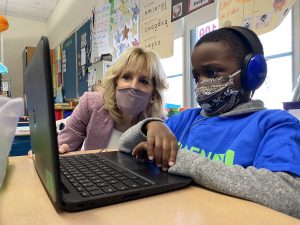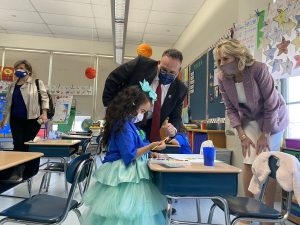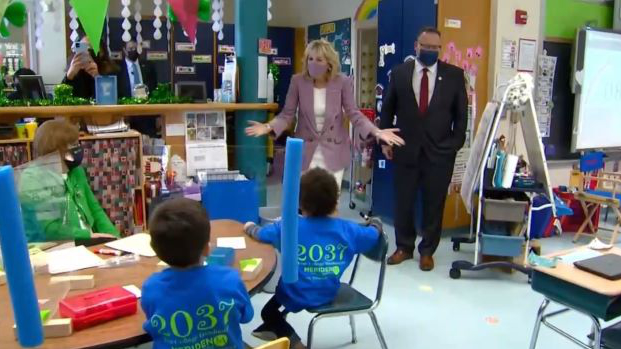On Miguel Cardona’s first full day as U.S. Secretary of Education the former educator was back in his hometown, welcoming First Lady Dr. Jill Biden to Meriden’s Benjamin Franklin Elementary School. The visit drew attention to the need to vaccinate educators, as Connecticut is already doing, and support schools through this difficult time with additional federal aid.
“As commissioner of education I experienced firsthand the disruption that communities and schools felt when the pandemic hit,” Cardona said. “As a former teacher and principal, I know the disruption that causes when you have to go from in-person on one day to fully remote another day.”
Though most Connecticut schools have been open for hybrid or full in-person learning since late August or September, that has not been the case in other places in the U.S.
Cardona said that to reopen schools it is critical “that we do it as safely as possible and as quickly as possible.”

First Lady Jill Biden asks a Meriden kindergartner about his reading work. Photo courtesy of the Hartford Courant.
He continued, “Schools are more than just places where students learn to read and write, they’re safe communities for children. That’s why the president took bold action yesterday to get teachers and school staff vaccinated quickly. I appreciate that leadership.”
After a CEA ad campaign in mid-February that called on the state to vaccinate school employees, teachers in Connecticut have begun receiving COVID vaccines this week.
In addition to vaccinating teachers and school staff, Cardona said reopening schools and keeping them open depends on Congress passing the American Rescue Plan.
He added that reopening schools is not just about turning on the lights and opening the doors. Because of the trauma they have faced, students will need the investment that the American Rescue Plan provides to receive the supports they need over the next several years.
“We need to make sure we have a long-term approach,” Cardona said.
Dr. Biden, who is a community college professor teaching remotely this semester, said last week when she asked her students how they’re doing they responded, “Dr. B, we’re doing okay, but we can’t wait to be back in the classroom.”
“We know we have to get back safely,” Biden said, “once we get teachers vaccinated and we get the American Rescue Plan passed.”

Secretary Cardona and Dr. Biden talk to a Meriden kindergartner about her school work. Photo courtesy of the Hartford Courant.
Saying the pandemic has been so hard on parents and teachers, Biden continued, “But look at what teachers have done in just a split second. They learned to teach virtually, they got food to the kids who needed it, the bus drivers drove the Wi-Fi hotspots so that kids could use their laptops. The whole system has come together, and they’ve done amazing things. I said, if Joe became the president, that one thing we were going to work to do is lift up the teachers, all the educators in this nation, because they deserve it.”
Before giving their prepared remarks, Biden and Cardona visited a kindergarten classroom, toured a sensory room, and talked with second-grade teacher Carla Wallace.
Wallace, who started the year teaching a group of remote learners, told the first lady how important it was to those children that their teacher’s attention was focused solely on them so she could form relationships and develop connections with them.
Connecticut educators who have been forced to split their attention between remote learners and in-person students this year have found that it means one group is constantly being short changed.
“That’s one of the biggest challenges I’ve heard as commissioner, and from across the country, is teachers who are trying to both teach remotely and in-person simultaneously,” Cardona said.
“We know that teaching in-person and remotely simultaneously is not sustainable,” said CEA President Jeff Leake. “It exacerbates inequalities and creates hardships for the students and the teachers who have to create two different lesson plans and split their time between two groups of students—not spending the necessary time with either group. It’s a practice that has to stop, and CEA is advocating for legislation that will put an end to synchronous learning going forward.”
Leake continued, “Watch for CEA Action Alert emails with information on how to contact your legislators and ask them to support us.”







